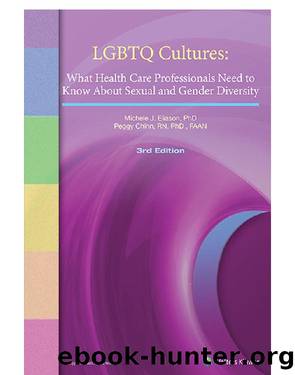LGBTQ Cultures by Unknown

Author:Unknown
Language: eng
Format: epub
Published: 2021-06-19T16:00:00+00:00
Ability/Disability Status
âPeople ask me which I am: Woman, disabled, Asian. I tell them I am all three, itâs like a triangle. It just depends on what is on top right now.â (Cupolo, Corbett, & Lewis, 1982, p. 3)
There is very little research on disability and LGBTQ people, for both disability and sexuality are taboo topics. In fact, the Institute of Medicine (2011) report on LGBT health, that reviewed all the literature on health-related issues, has only one sentence about disability: âDisability among LGBT elders is a topic rarely considered in research.â It is rarely considered as a topic at any age, although the inclusion of sexual orientation questions on the big health surveillance instruments is beginning to change that.
Like any other persons, LGBTQ people might be born with disabilities or acquire them at any point in life. Some of the recent data suggest that among LGBTQ adults, minority stress might combine with chronic health problems to create greater risk for disability and debilitation (Cochran & Mays, 2007; Fredriksen-Goldsen, Kim, Barkan, Muraco, & Hoy-Ellis, 2013; Fredriksen-Goldsen, Kim, & Barkan, 2012; Garland-Forshee, Fiala, Ngo, & Moseley, 2014; Wallace, Cochran, Durazo, & Ford, 2011), suggesting that LGBTQ people may be even more likely than people in the general population to become disabled. People with HIV/AIDS may also be more likely to suffer disabilities than those without HIV/AIDS. One study of lesbian/bisexual women with and without disabilities found many similarities in term of educational level, whether partnered, and mental health quality of life, but significant differences on income level and sense of connection to LGBT and womenâs communities (Eliason, Martinson, & Carabez, 2015).
OâToole (2000) noted several issues that disabled lesbians might have to deal with. These issues are probably relevant for other sexual and gender minority individuals as well:
There is a presumption of heterosexuality or asexuality by caregivers, healthcare professionals, and potential dates, making the LGBTQ person invisible.
The invisibility is in both LGBTQ communities and disability communities.
Many able-bodied LGBTQ people place high value on self-reliance and independence, making people with disabilities feel inadequate or excluded.
There is an absence of relevant sexuality education/information for people with disabilities.
There is very high potential for sexual abuse and/or exploitation of people with disabilities who may be more vulnerable because of physical, intellectual, or mental health disabilities.
There is an absence of LGBTQ role models with disabilities.
There are many complicated legal issues (e.g., guardianship, ability to freely choose partners if institutionalized, etc.).
Download
This site does not store any files on its server. We only index and link to content provided by other sites. Please contact the content providers to delete copyright contents if any and email us, we'll remove relevant links or contents immediately.
| Anthropology | Archaeology |
| Philosophy | Politics & Government |
| Social Sciences | Sociology |
| Women's Studies |
The Leavers by Lisa Ko(6472)
Born to Run: by Christopher McDougall(6259)
iGen by Jean M. Twenge(4702)
Sapiens by Yuval Noah Harari(4536)
The Kite Runner by Khaled Hosseini(4431)
Spare by Prince Harry The Duke of Sussex(4195)
Bullshit Jobs by David Graeber(3179)
Livewired by David Eagleman(3121)
Goodbye Paradise(2961)
Never by Ken Follett(2879)
A Dictionary of Sociology by Unknown(2518)
Harry Potter 4 - Harry Potter and The Goblet of Fire by J.K.Rowling(2416)
The Club by A.L. Brooks(2359)
People of the Earth: An Introduction to World Prehistory by Dr. Brian Fagan & Nadia Durrani(2346)
The Social Psychology of Inequality by Unknown(2309)
Machine Learning at Scale with H2O by Gregory Keys | David Whiting(2289)
Harry Potter and the Order of the Phoenix (5) by J.K. Rowling(2226)
0041152001443424520 .pdf by Unknown(2220)
Don't Sleep, There Are Snakes by Daniel L. Everett(2216)
